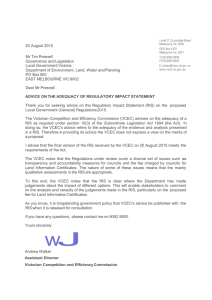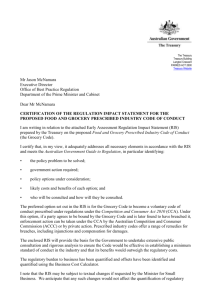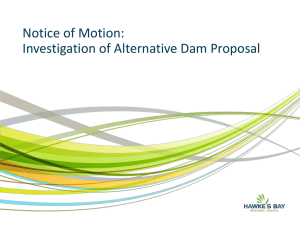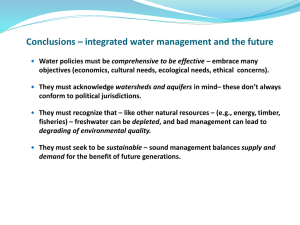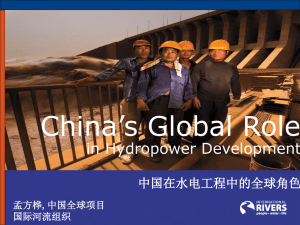Reservoir Induced Seismicity
advertisement
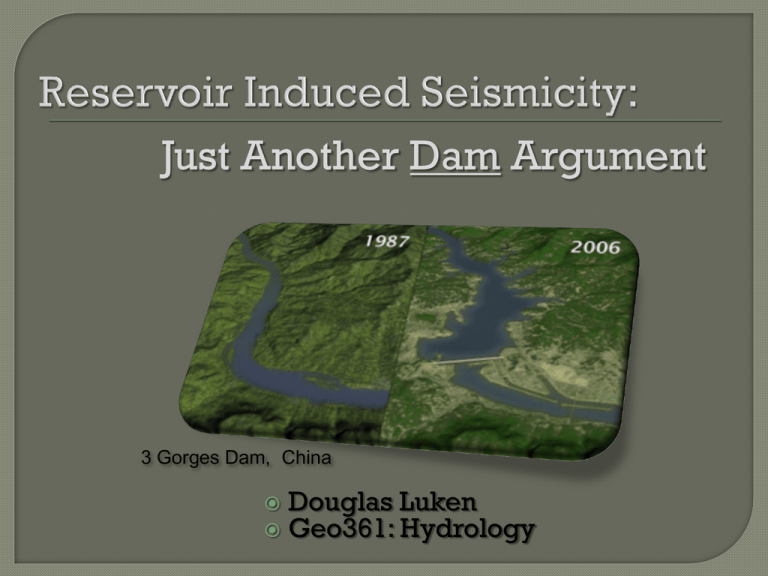
Just Another Dam Argument 3 Gorges Dam, China Douglas Luken Geo361: Hydrology Many state there is a difference between “Triggered” and “Induced” Induced : Is the significant change in load stress and/or pore pressure, causing a substantial change in the crust Triggered: If the crust is previously close to a fault failure due to natural processes, and only required a minor change in load or pore pressure In this presentation we will assume they are one in the same. “…earthquakes occurring in the vicinity of artificial water reservoirs as a consequence of impounding.” (Gupta, Harsh K., 2002.) Depth of the water is the most significant factor (Volume is also a sig. factor) One characteristic of RIS is that the magnitude of the foreshock is higher than the magnitude of the aftershock and both values are generally higher than in cases of natural earthquakes (USGS, 2006) RIS can be immediately noticed during filling periods of reservoirs, and can also occur later in the life of the reservoir. Also occurs after a rapid change in reservoir water level. Monthly variation in reservoir water depth and seismic activity as recorded by an analogue station near the dam wall Original and Relocated EQ Hypocentres Original locations with error bars, shown (a) in map view and (b) in cross section. Relocated EQs, with their much reduced error bars, (c) in map form and (d) in cross section. The shaded area of the map is the Au Reservoir. Hoover Dam • Completed in 1935 • 100’s of Earthquakes occurred as the water rose to its peak height of 475ft in 1939 Konya, India • Completed in 1963 • M ≥6.3 Earthquake in 1967 Three Gorges Dam • Main Body Completed 2006 • 7661ft long • 1045km² surface area Dam Height (m) Impounding Began Largest EQ Magnitude China 154 2004 2008 7.9 Koya India 103 1962 1967 6.3 Kariba Zambia 128 1958 1963 6.2 Kremasta Greece 160 1965 1966 6.2 Xinfengjiang China 105 1959 1962 6.1 Srinakharin Thailand 140 1977 1983 5.9 Marathon Greece 67 1929 1938 5.7 Oroville USA 236 1967 1975 5.7 Aswan Eygpt 111 1964 1981 5.6 Benmore New Zealand 110 1964 1966 5 Eucumbene Australia 116 1957 1959 5 Hoover USA 221 1935 1939 5 Bamjina Yugoslavia 90 1966 1967 4.5-5.0 Bhasta India 88 1981 1983 4.9 Kerr USA 60 1958 1971 4.9 Kurobe Japan 186 1960 1961 4.9 Monteyard France 155 1962 1963 4.9 Shenwo China 50 1972 1974 4.8 Akosombo Ghana 134 1964 1964 4.7 Canelles Spain 150 1960 1962 4.7 Dam Zipingpu Country Reported Cases of RIS with M ≥ 4.0 *Source T.Valdut, Enviromental Aspects of Reservoir Induced Seismicity, May 1993 • Up to 2008, there were 96 large dam sites that had reported RIS • 5 sites with a M ≥ 6.0 • 10 with M 5.0 – 5.9 ~ These include China, Zambia, India and Greece • 28 with M 4.0 – 4.9 • 53 with M < 4.0 Others reported but not included, due to lack of proper equipment primarily in 3rd world countries RIS is a under-funded and often neglected field of research. The increase in government support for monitoring stations and research for dams worldwide. Earthquake hazard assessments done as part of the dam design process Better monitoring of seismic activity during impoundment, change or possible reverse filling procedures done if RIS is detected, and model the changes to pore pressure and mechanics underground. Open disclosure of RIS occurrences during the initial impounding There is resistance in the engineering community globally to accept the significant or even existence of RIS. There is no correlation to properly demonstrate between earthquakes and reservoirs If the natural seismicity is low, the danger of RIS is low as well. No dam has yet to fail disastrously due to RIS, and the dangers are being over exaggerated


